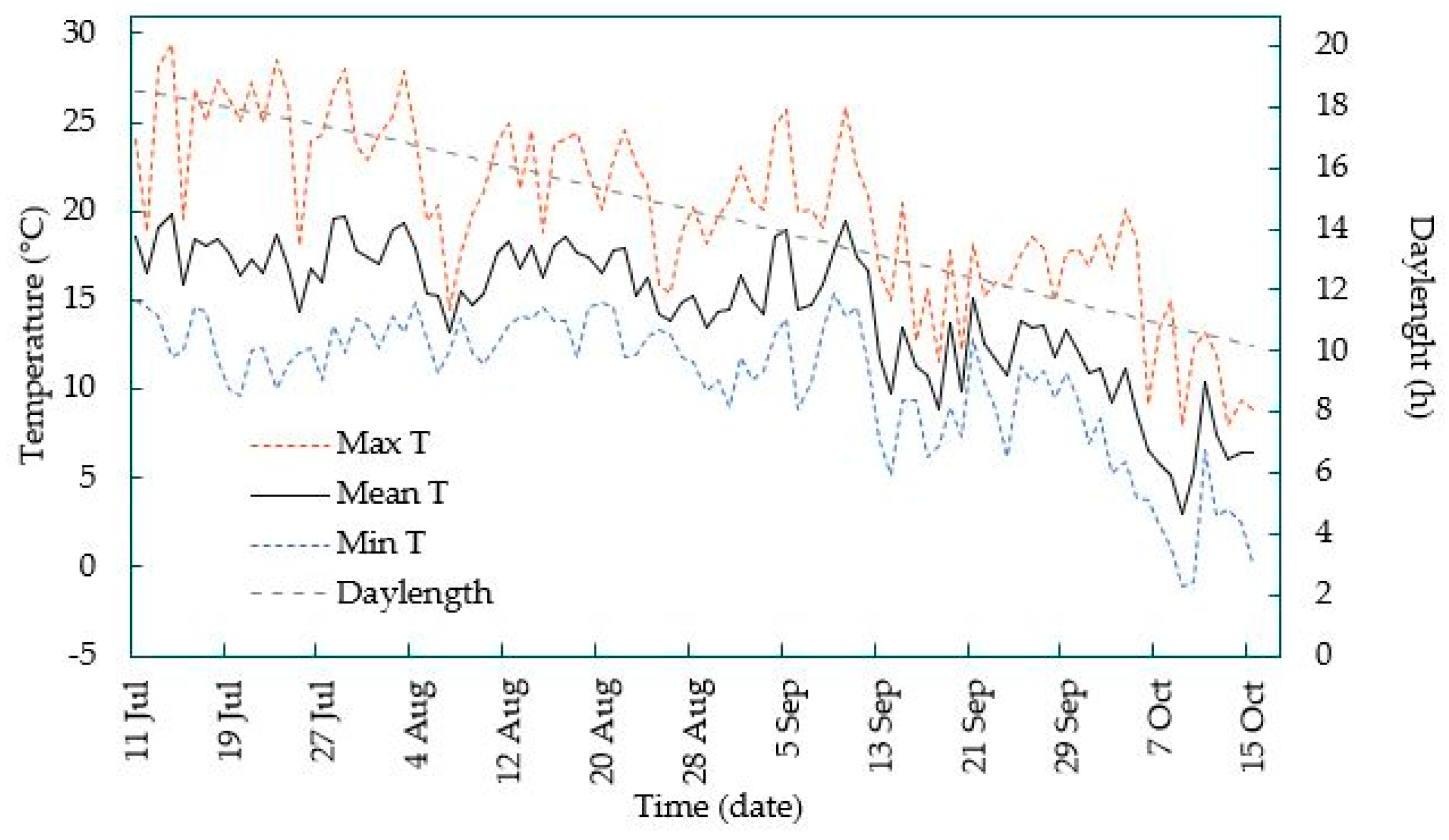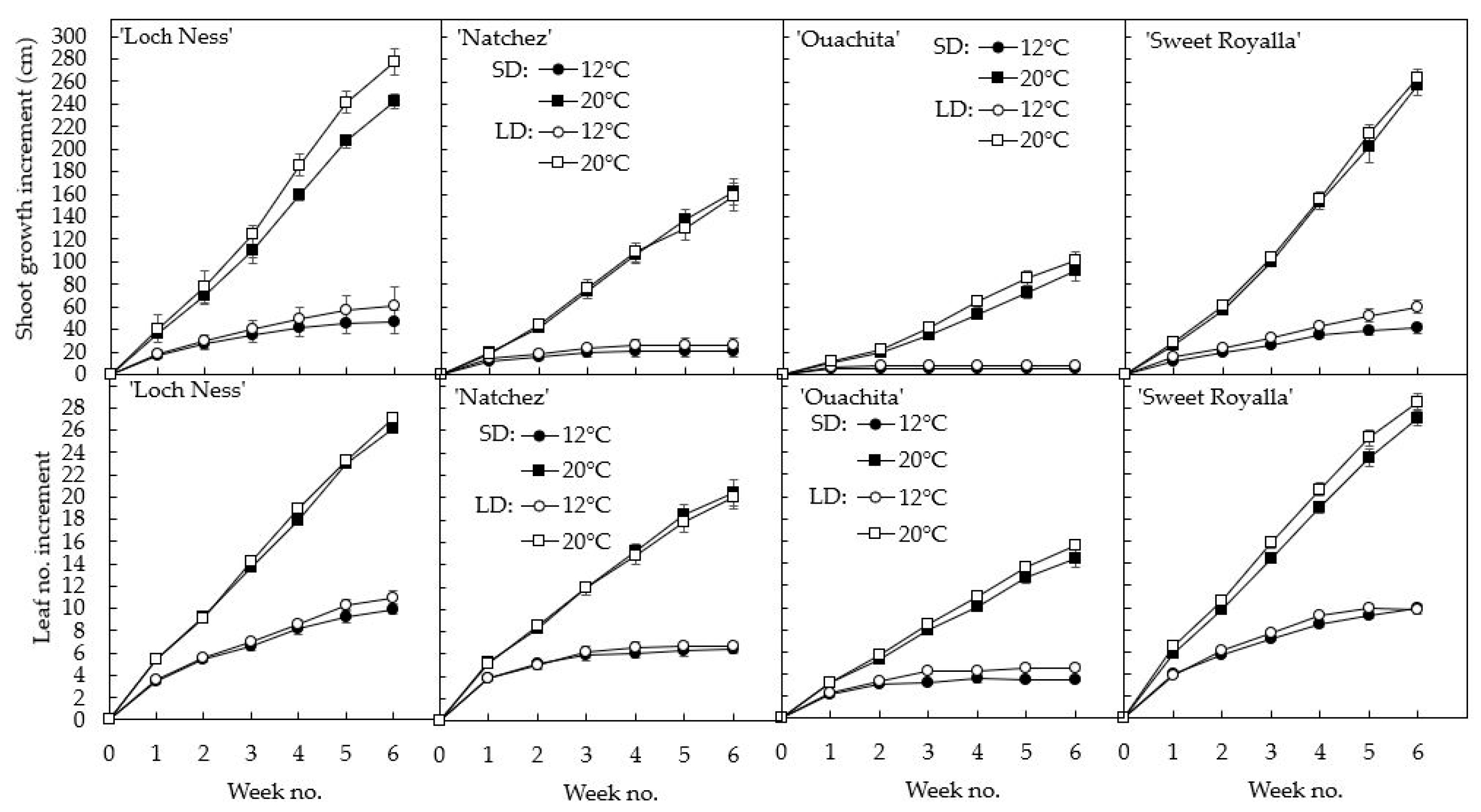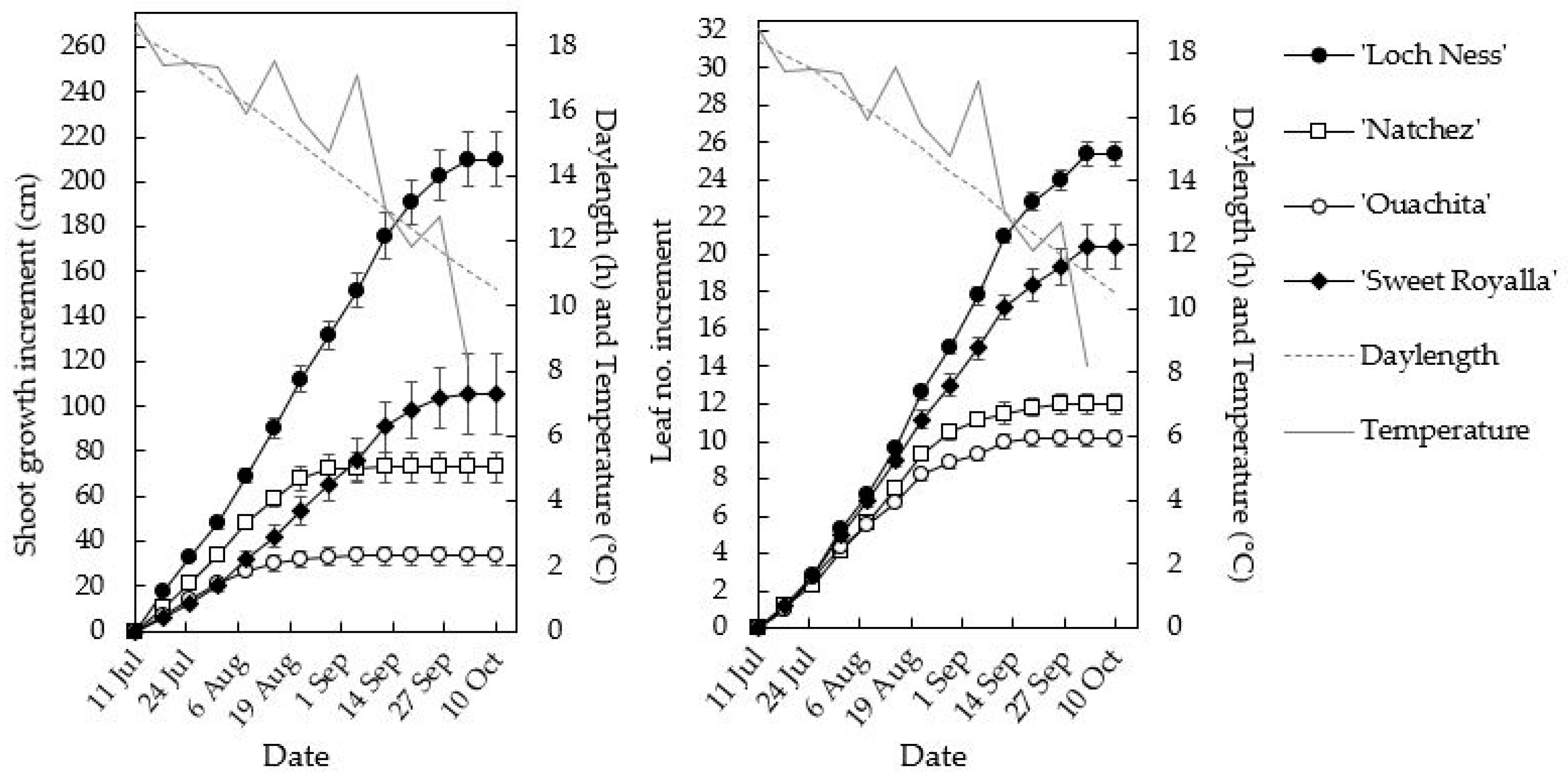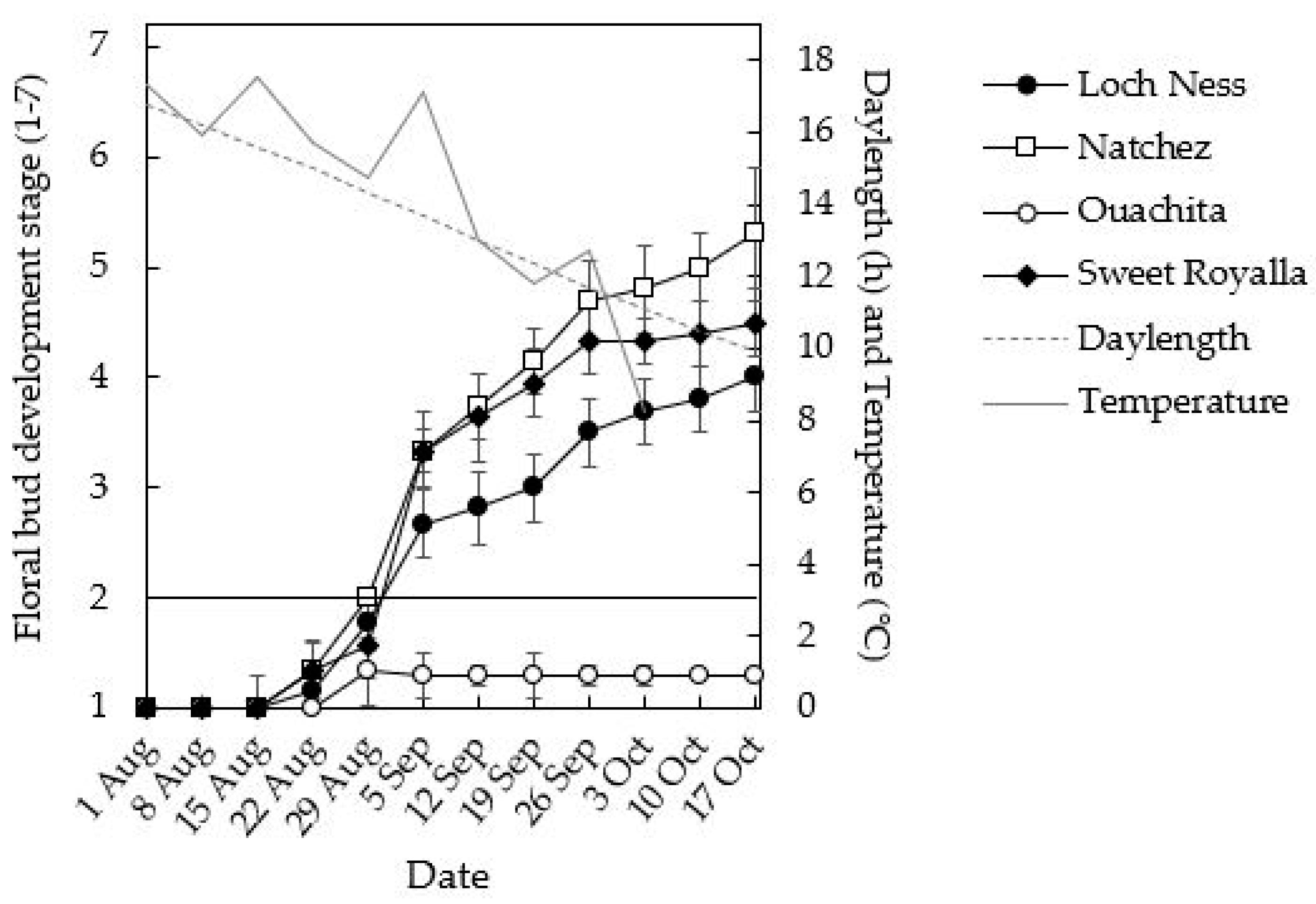Temperature and Photoperiod Control of Shoot Growth and Floral Bud Initiation in Biennial-Fruiting Blackberries
Abstract
1. Introduction
2. Materials and Methods
2.1. General
2.2. Phytotron Experiment
2.3. Field Experiment
3. Results
3.1. Phytotron Experiment
3.2. Field Experiment
4. Discussion
5. Conclusions
Author Contributions
Funding
Data Availability Statement
Acknowledgments
Conflicts of Interest
References
- Heide, O.M.; Sønsteby, A. Physiology of flowering and dormancy regulation in annual- and biennial-fruiting red raspberry (Rubus idaeus L.)—A review. J. Hortic. Sci. Biotechnol. 2011, 86, 433–442. [Google Scholar] [CrossRef]
- Strik, B.C.; Clark, J.R.; Finn, C.E.; Banados, P. Worldwide production of blackberries, 1995 to 2005 and prediction for growth. HortTechnology 2007, 17, 205–213. [Google Scholar] [CrossRef]
- Waldo, G.F. Fruit bud formation in brambles. Proc. Am. Soc. Hortic. Sci. 1933, 30, 263–267. [Google Scholar]
- Robertson, M. Further investigation of flower-bud development in the genus Rubus. J. Hortic. Sci. 1957, 32, 265–273. [Google Scholar] [CrossRef]
- Takeda, F.; Wisniewski, M. Organogenesis and patterns of floral bud development in two eastern thornless blackberry cultivars. J. Am. Soc. Hortic. Sci. 1989, 114, 528–531. [Google Scholar] [CrossRef]
- Warmund, M.R.; George, M.F.; Ellersieck, M.R.; Slater, J.V. Susceptibility of blackberry tissue to freezing injury after exposure to 16 °C. J. Am. Soc. Hortic. Sci. 1989, 114, 795–800. [Google Scholar] [CrossRef]
- Takeda, F.; Strik, B.C.; Peacock, D.; Clark, J.R. Cultivar differences and the effect of winter temperature on flower bud development in blackberry. J. Am. Soc. Hortic. Sci. 2002, 127, 495–501. [Google Scholar] [CrossRef]
- Takeda, F.; Strik, B.C.; Peacock, D.; Clark, J.R. Patterns of Floral Bud Development in Canes of Erect and Trailing Blackberries. J. Am. Soc. Hortic. Sci. 2003, 128, 3–7. [Google Scholar] [CrossRef]
- Moore, J.N.; Caldwell, J.D. 1985. Rubus. In Handbook of Flowering; Halevy, A.H., Ed.; CRC Press: Boca Raton, FL, USA, 1985; Volume IV, pp. 226–238. [Google Scholar]
- Strik, B.C. Flowering and fruiting on command in berry crops. Acta Hortic. 2012, 926, 197–214. [Google Scholar] [CrossRef]
- Sønsteby, A.; Heide, O.M. Temperature and daylength effects on growth and floral initiation in biennial-fruiting blackberry. Horticulturae 2023, 9, 1285. [Google Scholar] [CrossRef]
- Williams, I.H. Effects of environment on Rubus idaeus L. IV. Flower formation and development of the inflorescence. J. Hortic. Sci. 1959, 34, 219–228. [Google Scholar] [CrossRef]
- Sønsteby, A.; Heide, O.M. Environmental control of growth and flowering of Rubus idaeus L. cv. Glen Ample. Sci. Hortic. 2008, 117, 249–256. [Google Scholar] [CrossRef]
- Sadojevic, M. Growth and Development of Blackberry Cultivars. Master’s Thesis, Norwegian University of Life Sciences, Ås, Norway, 2024. Available online: https://hdl.handle.net/11250/3148386 (accessed on 21 November 2024).
- Clark, J.R.; Moore, J.N. ‘Ouachita’ thornless blackberry. HortScience 2005, 40, 258–260. [Google Scholar] [CrossRef]
- Clark, J.R.; Moore, J.N. ‘Natchez’ Thornless Blackberry. HortScience 2008, 43, 1897–1899. [Google Scholar] [CrossRef]
- Clark, J.R. ‘Osage’ Thornless Blackberry. HortScience 2013, 48, 909–912. [Google Scholar] [CrossRef]
- Palonen, P.; Pohjola, M.; Karhu, S. Cropping potential of raspberry long cane plants as affected by their growing condition and the duration of storage. J. Hortic. Sci. Biotechnol. 2015, 90, 738–746. [Google Scholar] [CrossRef]
- Sønsteby, A.; Heide, O.M. Estimating the temperature limitations for growth cessation and floral initiation in early- and late-inducing red raspberry cultivars (Rubus idaeus) and the floral-inducing effect of winter chilling. J. Hortic. Sci. Biotech. 2024. [Google Scholar] [CrossRef]
- Hodnefjell, R.; Heide, O.M.; Rivero, R.; Remberg, S.F.; Sønsteby, A. Control of growth cessation and floral initiation in red raspberry (Rubus idaeus L.) cultivars of diverse origin in controlled and natural environments. Sci. Hortic. 2018, 233, 412–420. [Google Scholar] [CrossRef]






| Source of Variation | Height Growth Increment (cm) | Node Number Increment |
|---|---|---|
| Temperature (A) | <0.001 | 0.002 |
| Photoperiod (B) | 0.01 | 0.02 |
| Cultivar (C) | <0.001 | <0.001 |
| A × B | n.s. | n.s. |
| A × C | <0.001 | <0.001 |
| B × C | n.s. | n.s. |
| A × B × C | n.s. | n.s. |
| Cultivar | Temperature (°C) | Photoperiod (h) | Flowering Plants (%) | Days to Anthesis * | Flowers per Plant | Flowering Nodes (%) | Non-Breaking Nodes (%) | Flowers per Lateral | Lateral Length (cm) |
|---|---|---|---|---|---|---|---|---|---|
| ‘Loch Ness’ | 12 | 10 | 100 | 59.5 c | 206 | 74.7 a | 7.3 | 12.8 | 47.4 |
| 20 | 100 | 60.8 c | 189 | 68.9 a | 21.6 | 11.2 | 49.8 | ||
| Mean | 100 | 60.2 CD | 197 B | 71.8 A | 14.4 C | 12.0 A | 48.6 B | ||
| 20 | 10 | 100 | 47.8 de | 276 | 49.0 c | 16.8 | 15.2 | 41.8 | |
| 20 | 100 | 54.2 d | 223 | 52.2 bc | 16.6 | 12.9 | 54.2 | ||
| Mean | 100 | 51.0 EF | 250 A | 52.6 B | 16.7 BC | 14.0 A | 48.0 BC | ||
| ‘Natchez’ | 12 | 10 | 50 | 78.5 a | 11 | 16.6 f | 24.1 | 3.1 | 46.0 |
| 20 | 100 | 44.3 e | 15 | 27.0 ef | 19.6 | 2.8 | 44.1 | ||
| Mean | 75 | 61.4 C | 13 E | 21.8 E | 21.9 BC | 3.0 E | 45.0 CD | ||
| 20 | 10 | 100 | 43.7 e | 22 | 24.5 ef | 57.5 | 2.9 | 34.9 | |
| 20 | 100 | 43.7 e | 33 | 32.1 de | 41.0 | 3.5 | 36.1 | ||
| Mean | 100 | 43.7 F | 28 DE | 28.3 D | 49.3 A | 3.2 DE | 35.5 D | ||
| ‘Ouachita’ | 12 | 10 | 100 | 81.2 a | 28 | 30.3 e | 53.5 | 6.4 | 61.5 |
| 20 | 100 | 77.8 a | 46 | 46.2 cd | 31.8 | 6.7 | 62.1 | ||
| Mean | 100 | 79.6 A | 37 DE | 38.3 C | 42.7 A | 6.5 BC | 61.8 A | ||
| 20 | 10 | 100 | 71.7 b | 34 | 25.8 ef | 36.7 | 5.4 | 63.7 | |
| 20 | 100 | 72.7 b | 64 | 50.6 bc | 22.3 | 5.9 | 57.6 | ||
| Mean | 100 | 72.2 B | 49 D | 38.2 C | 29.5 B | 5.7 CD | 60.6 A | ||
| ‘Sweet Royalla’ | 12 | 10 | 100 | 54.2 d | 122 | 70.6 a | 24.3 | 7.0 | 44.4 |
| 20 | 100 | 52.7 d | 124 | 72.5 a | 16.8 | 6.5 | 39.5 | ||
| Mean | 100 | 53.4 DE | 123 C | 71.6 A | 20.5 BC | 6.7 BC | 42.0 BCD | ||
| 20 | 10 | 100 | 51.2 d | 193 | 62.5 ab | 9.7 | 8.1 | 44.2 | |
| 20 | 100 | 59.8 c | 181 | 54.2 bc | 14.7 | 8.1 | 41.3 | ||
| Mean | 100 | 55.5 DE | 187 B | 58.3 B | 12.2 C | 8.1 B | 42.8 BCD | ||
| Probability levels of significance (ANOVA) | |||||||||
| Source of variation | |||||||||
| Temperature (A) | 0.02 | 0.001 | 0.05 | n.s. | n.s. | n.s. | |||
| Photoperiod (B) | 0.02 | n.s. | 0.05 | n.s. | n.s. | n.s. | |||
| Cultivar (C) | <0.001 | <0.001 | <0.001 | <0.001 | <0.001 | <0.001 | |||
| A × B | 0.001 | n.s. | n.s. | n.s. | n.s. | n.s. | |||
| A × C | 0.004 | n.s. | <0.001 | <0.001 | n.s. | n.s. | |||
| B × C | 0.001 | n.s. | 0.001 | 0.04 | n.s. | n.s. | |||
| A × B × C | 0.01 | n.s. | n.s. | n.s. | n.s. | n.s. | |||
| Cultivar | Total Shoot Height (cm) | Total Leaf Number per Plant | Internode Length (cm) |
|---|---|---|---|
| ‘Loch Ness’ | 237.2 ± 24.3 | 34.0 ± 1.1 | 8.2 ± 0.7 |
| ‘Natchez’ | 93.3 ± 13.7 | 21.2 ± 1.8 | 6.0 ± 1.0 |
| ‘Ouachita’ | 50.7 ± 8.9 | 19.2 ± 0.7 | 3.2 ± 0.7 |
| ‘Sweet Royalla’ | 121.6 ± 37.0 | 30.0 ± 2.5 | 5.0 ± 1.4 |
| Mean | 125.8 | 25.5 | 5.6 |
| Cultivar | Total No. of Flowers per Plant 1 | % Flowering Buds 1 | ||
|---|---|---|---|---|
| 0 Weeks Chilling | 16 Weeks Chilling | 0 Weeks Chilling | 16 Weeks Chilling | |
| ‘Loch Ness’ | 0.0 ± 0.0 | 75.3 ± 34.6 | 0.0 ± 0.0 | 30.6 ± 10.4 |
| ‘Natchez’ | 1.0 ± 0.0 | 31.0 ± 10.0 | 1.6 ± 2.7 | 39.1 ± 15.7 |
| ‘Ouachita’ | 0.0 ± 0.0 | 2.8 ± 2.6 | 0.0 ± 0.0 | 12.8 ± 4.3 |
| ‘Sweet Royalla’ | 3.0 ± 0.1 | 82.0 ± 27.0 | 10.5 ± 0.7 | 43.8 ± 12.3 |
| Mean | 2.6 | 50.1 | 3.1 | 31.1 |
Disclaimer/Publisher’s Note: The statements, opinions and data contained in all publications are solely those of the individual author(s) and contributor(s) and not of MDPI and/or the editor(s). MDPI and/or the editor(s) disclaim responsibility for any injury to people or property resulting from any ideas, methods, instructions or products referred to in the content. |
© 2024 by the authors. Licensee MDPI, Basel, Switzerland. This article is an open access article distributed under the terms and conditions of the Creative Commons Attribution (CC BY) license (https://creativecommons.org/licenses/by/4.0/).
Share and Cite
Sønsteby, A.; Sadojevic, M.; Heide, O.M. Temperature and Photoperiod Control of Shoot Growth and Floral Bud Initiation in Biennial-Fruiting Blackberries. Horticulturae 2024, 10, 1297. https://doi.org/10.3390/horticulturae10121297
Sønsteby A, Sadojevic M, Heide OM. Temperature and Photoperiod Control of Shoot Growth and Floral Bud Initiation in Biennial-Fruiting Blackberries. Horticulturae. 2024; 10(12):1297. https://doi.org/10.3390/horticulturae10121297
Chicago/Turabian StyleSønsteby, Anita, Mirjana Sadojevic, and Ola M. Heide. 2024. "Temperature and Photoperiod Control of Shoot Growth and Floral Bud Initiation in Biennial-Fruiting Blackberries" Horticulturae 10, no. 12: 1297. https://doi.org/10.3390/horticulturae10121297
APA StyleSønsteby, A., Sadojevic, M., & Heide, O. M. (2024). Temperature and Photoperiod Control of Shoot Growth and Floral Bud Initiation in Biennial-Fruiting Blackberries. Horticulturae, 10(12), 1297. https://doi.org/10.3390/horticulturae10121297






